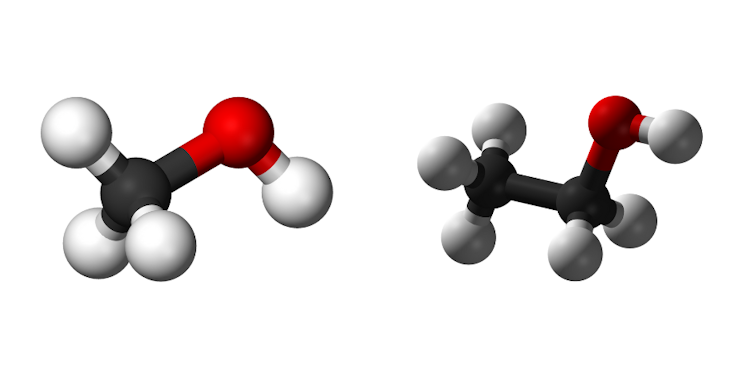
Pharmacology lecturer IAN MUSGRAVE explains methanol and how it gets into drinks and causes harm.
Two Australian teenagers, Holly Bowles and Bianca Jones, have died after experiencing suspected methanol poisoning while they were travelling in Laos.
They are among six tourists reported to have died – also including a British woman, an American and two Danes – after becoming ill from unknowingly consuming alcoholic drinks containing methanol.
So what is methanol, and how does it make people sick?
Methanol versus ethanol
Methanol is an alcohol, like the familiar ethanol we consume in alcoholic beverages.
Like ethanol, methanol is a colourless, flammable liquid. It has a smell similar to ethanol as well.
But the two have different chemical structures. Methanol is composed of only one carbon atom, while ethanol has two.

That one carbon atom makes all the difference. It means methanol is processed differently in our bodies and is much more toxic than ethanol.
Methanol is used in a variety of industrial and household products, such as windshield cleaning fluids, antifreeze and fuel. It’s not safe for human consumption.
What makes methanol toxic?
The difference is in how methanol is metabolised, or broken down in our bodies.
Ethanol is metabolised into a chemical compound called acetaldehyde. Acetaldehyde is toxic, but is rapidly converted to acetate (also known as acetic acid, found in vinegar). Generating an acid may sound bad, but acetate actually produces energy and makes important molecules in the body.
By contrast, methanol is metabolised into formaldehyde (a chemical used in industrial glues and for embalming corpses, for example) and then to formic acid (the chemical in some ant bites that makes them hurt so much).
Unlike acetate, which the body uses, formic acid poisons the mitochondria, the powerhouses of the cells.
As a result, a person exposed to methanol can go into severe metabolic acidosis, which is when too much acid builds up in the body.
Methanol poisoning can cause nausea, vomiting, and abdominal pain. The acidosis then causes depression of the central nervous system which can cause people with methanol poisoning to fall unconscious and go into a coma, as well as retinal damage leading to vision loss. This is because the retinas are full of active mitochondria and sensitive to them being damaged.
Death is not inevitable if only a small amount of methanol has been consumed, and rapid treatment will greatly reduce damage.
However, permanent vision damage can occur even at non-lethal doses if treatment is not administered quickly.
What does treatment involve?
Treatment is mainly supportive care, such as intubation and mechanical ventilation to help the patient to breathe.
But it can also involve drugs such as fomepizole (which inhibits the generation of toxic formic acid) and dialysis to remove methanol and its metabolites from the body.
How does methanol get into alcoholic drinks?
Methanol can turn up in any alcoholic beverage, but it’s most likely in beverages with higher alcohol content, such as spirits, and traditionally brewed drinks, such as fruit wines.
Methanol can get into alcoholic beverages in a number of ways. Sometimes it’s added deliberately and illegally during or after manufacturing as a cheaper way to increase the alcohol content in a drink.
Traditional brewing methods can also inadvertently generate methanol as well as ethanol and produce toxic levels of methanol depending on the microbes and the types of plant materials used in the fermentation process.
We don’t yet know how the Australian teenagers came to be poisoned in this tragedy. But it is a good idea when travelling (particularly in areas with traditionally fremented drinks, such as south-east Asia, the Indian subcontinent and parts of Africa) to always be careful.
The Australian government’s Smartraveller website advises that to avoid methanol poisoning you should be careful drinking cocktails and drinks made with spirits, drink only at reputable licensed premises and avoid home-made alcoholic drinks.
Drinking only mass-produced commercial brews can be safer, though understandably people often want to try locally made drinks as part of their adventure.![]()
Ian Musgrave, Senior lecturer in Pharmacology, University of Adelaide. Republished from The Conversation.
Who can be trusted?
In a world of spin and confusion, there’s never been a more important time to support independent journalism in Canberra.
If you trust our work online and want to enforce the power of independent voices, I invite you to make a small contribution.
Every dollar of support is invested back into our journalism to help keep citynews.com.au strong and free.
Thank you,
Ian Meikle, editor









Leave a Reply